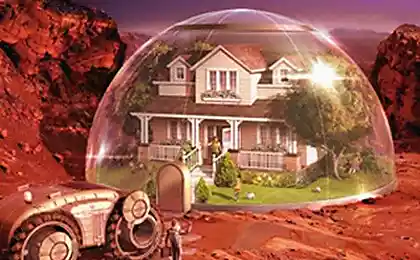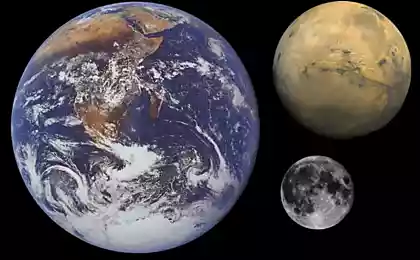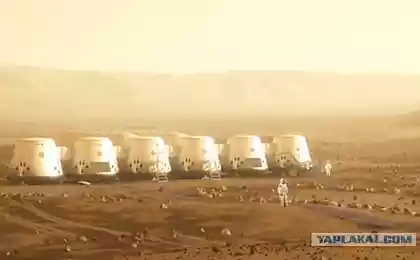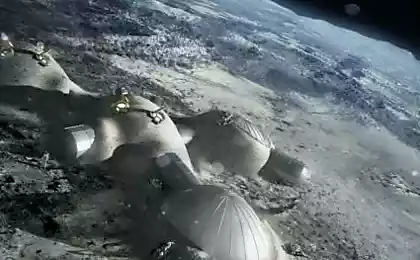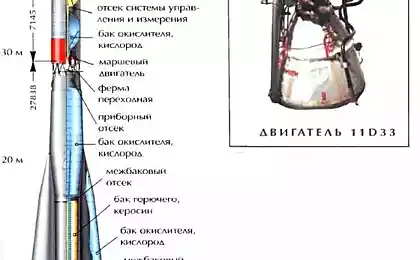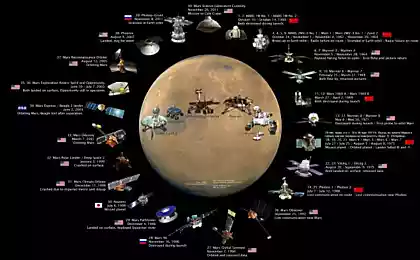1723
You can look at Mars
It's no secret that Mars Phoenix Lander was detected water ice. Studies have shown that the observed ice evaporates into the atmosphere, bypassing the liquid stage. Martian atmosphere creates the perfect conditions for this evaporation, it is very thin, dry and cold. How cold? You can find out for sure! Phoenix Lander aired live. For example, the October 27, 2008 from -45 to -89 Celsius.
What do we know about the atmosphere of Mars? It is hundreds of times thinner than the atmosphere of the Earth consists of 95% carbon dioxide, 3% nitrogen, 1.6% argon, and contains traces of oxygen, water, and methane. According to the observations we know that on Mars there are many sand storms, dust devils, clouds and gusty winds. Currently, six stations are exploring Mars (two rover, the lander and three orbiters) and has already received thousands of images. But only some of them show atmospheric phenomena. Presented photoselection contains some of the best images of the Martian atmosphere.
Northern orange sky of Mars, the horizon and the landscape, photographed by NASA-vskim Phoenix. Solar battery lander and a manipulator in the frame. The image was taken just before the sample was taken manipulator under a microscope system Surface Stereo Imager on Phoenix's 16th Martian day after landing.
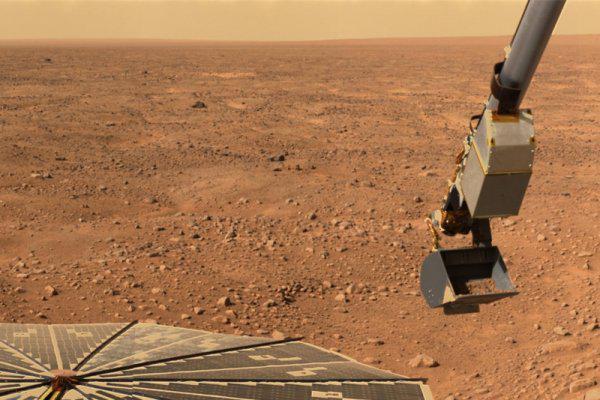
Brownish gray sky at sunset. True-color image receiving module Pathfinder on Mars in the 24th Martian day stay on the surface (22 June 1996). Please note that the sky around the sun is light blue.

High ice clouds swirling over Mars. The image was taken with the camera on the Mars orbital station on July 6, 2005. The cloud spread to more than 30 kilometers above the Martian surface. Such phenomena are common in late spring in the south-west of the volcano Arsia Mons
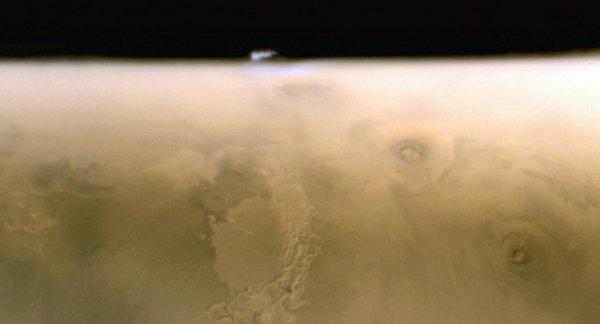
Clouds above the crater in the middle of the season of dust storms in the southern hemisphere of Mars. This image unnamed crater to the south-east of the Hellas basin shows how storm covers the region. 2001. Also from orbit. 17 m / pixel.
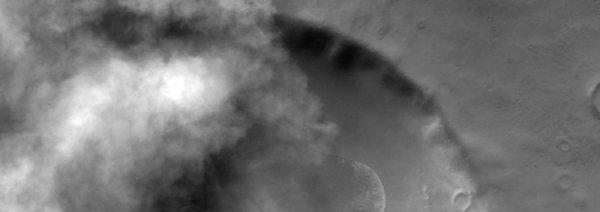
Dust devil, top view. Usually they are formed in the afternoon, because you have a sufficient amount of time to sunlight should be as heated surface. The image was taken around 15:08 local time. The diameter of this dust devil is about 200 meters. Judging by the length of the shadow in this image, its height is about 500 meters.
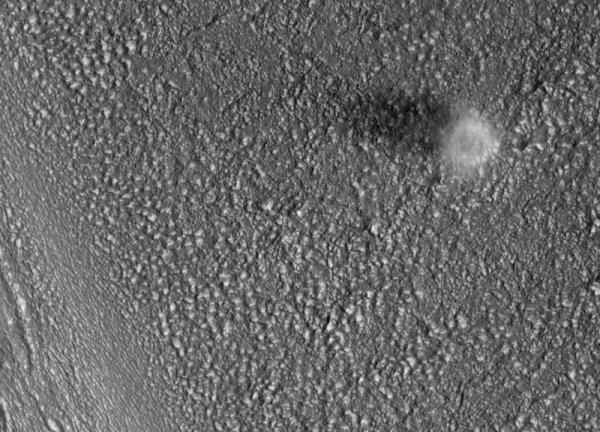
Martian sky and landscape. Desert. Fascinating picture. Ever set foot here and the human foot. This is part of a larger image called "McMurdo» («McMurdo»), received the Martian winter 2006 rover Spirit. Look closely at the surface of the visible traces.
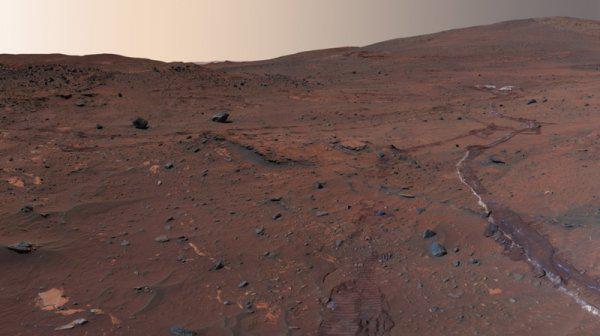
In the photo above the clouds rim of the crater Endurance. Images are transferred rover Opotyuniti (Opportunity) on 269th Martian day stay on the surface (26 Oct 2004). In general, then, if the picture does not sign, the picture can be taken as typical of the earth. (
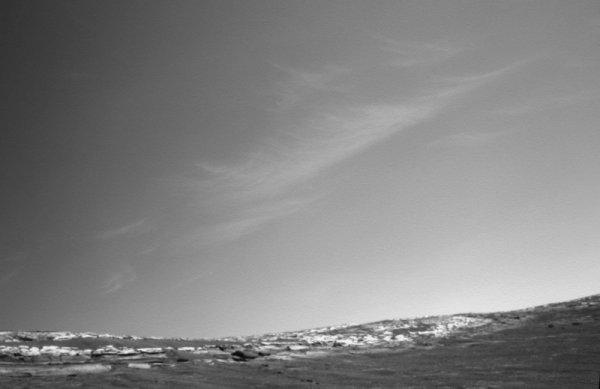
Dust storm in early spring at the north pole of Mars. At this time of the Martian year is typical for polar regions. As the north polar cap, which is frozen carbon dioxide begins to melt, the temperature difference between the melted areas and still frozen generates strong swirling wind. In the photo in 2002 and you can see some dust storms.
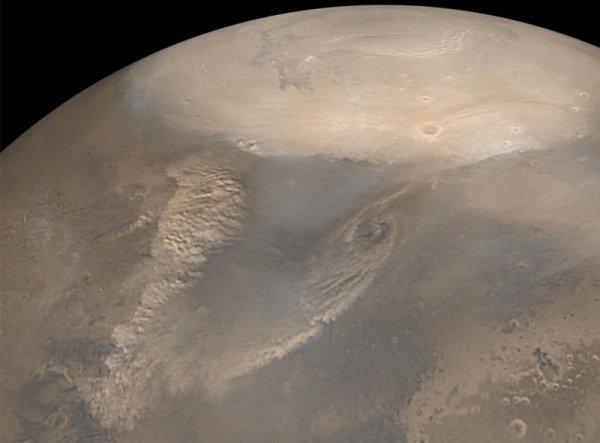
Another view of the Martian landscape we passed rover Opotyuniti. Clouds are made up of carbon dioxide ice particles or pieces of ice water and can rapidly move across the sky.

Much of the Martian surface is covered with a dust storm. 2001. The picture with the space station. By early July, the Martian atmosphere was so foggy that photograph the surface is not possible, it just could not be seen.
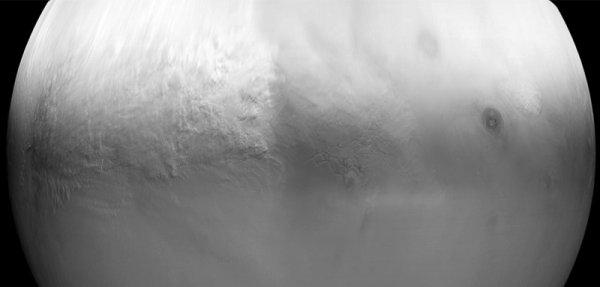
The air on Mars is dense enough to fill the parachute. May 25, 2008 was made this interesting photograph showing the descent of the lander Phoenix on a parachute on the surface of Mars. Phoenix is seen in the 10-km crater with the unofficial name «Heimdall». Although it seems that Phoenix almost landed on the slope of the crater, but it's not. The camera angle gives a misleading result. Actually lander about 13 kilometers above the surface.
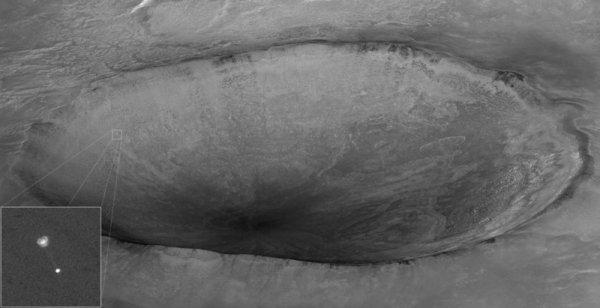
May 19, 2005 NASA's Mars rover Spirit has made this a great shot. The sun set below the rim of Gusev Crater. This panorama was photographed around 6:07 pm 489th Martian day stay rover on the planet. False-color image. It is similar to how it would have seen the man, but with a little more vivid colors.
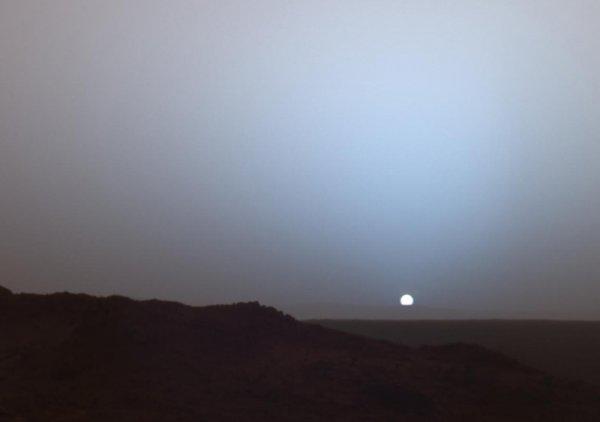
This is one of the two moons of Mars. Phobos (Phobos) as of March 23, 2008 at a distance of 6800 kilometers. Translated from the Greek - fear. Looks ominous, does not it? Phobos rotates around its axis in the same period as that around Mars, so it is always turned to the planet of the same party. Its orbit is inside the Roche limit, and the satellite is not broken only by his inner strength. This arrangement orbit causes that Phobos break stones, often leaving noticeable furrows on the surface of the satellite. It is seen that the surface is studded with craters, the largest of which - Stickney - on top of the photo - has a diameter of 9 km. Such an attack had just spread a little companion pieces, but that did not happen. Durable stone. By the way, it is not great - the illuminated part, we see only about 21 kilometers in diameter.
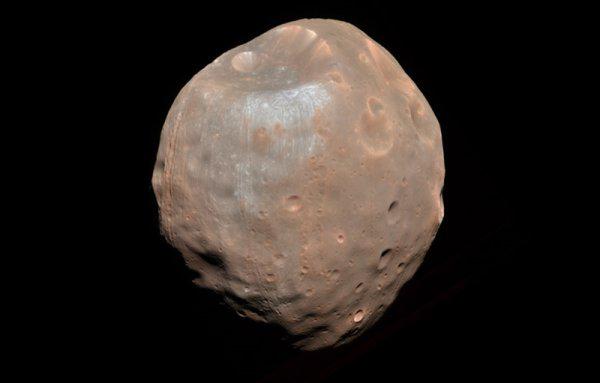
On the Martian sky you can see the Earth and the Moon. This is how it looks. Photo of 3 October 2007, made with the orbit of Mars. To the Earth 142 million kilometers.
The next expedition to Phobos is scheduled for 2011 in the framework of the "Phobos-Grunt" Russian Space Agency.
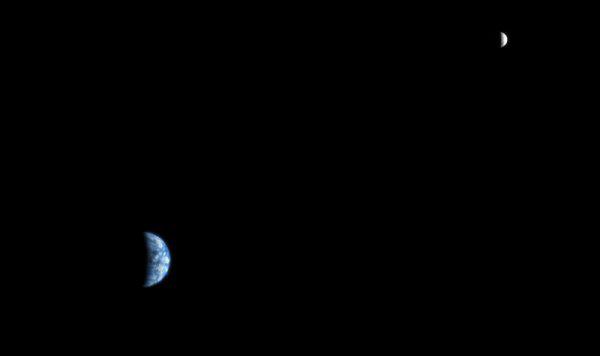
What do we know about the atmosphere of Mars? It is hundreds of times thinner than the atmosphere of the Earth consists of 95% carbon dioxide, 3% nitrogen, 1.6% argon, and contains traces of oxygen, water, and methane. According to the observations we know that on Mars there are many sand storms, dust devils, clouds and gusty winds. Currently, six stations are exploring Mars (two rover, the lander and three orbiters) and has already received thousands of images. But only some of them show atmospheric phenomena. Presented photoselection contains some of the best images of the Martian atmosphere.
Northern orange sky of Mars, the horizon and the landscape, photographed by NASA-vskim Phoenix. Solar battery lander and a manipulator in the frame. The image was taken just before the sample was taken manipulator under a microscope system Surface Stereo Imager on Phoenix's 16th Martian day after landing.

Brownish gray sky at sunset. True-color image receiving module Pathfinder on Mars in the 24th Martian day stay on the surface (22 June 1996). Please note that the sky around the sun is light blue.

High ice clouds swirling over Mars. The image was taken with the camera on the Mars orbital station on July 6, 2005. The cloud spread to more than 30 kilometers above the Martian surface. Such phenomena are common in late spring in the south-west of the volcano Arsia Mons

Clouds above the crater in the middle of the season of dust storms in the southern hemisphere of Mars. This image unnamed crater to the south-east of the Hellas basin shows how storm covers the region. 2001. Also from orbit. 17 m / pixel.

Dust devil, top view. Usually they are formed in the afternoon, because you have a sufficient amount of time to sunlight should be as heated surface. The image was taken around 15:08 local time. The diameter of this dust devil is about 200 meters. Judging by the length of the shadow in this image, its height is about 500 meters.

Martian sky and landscape. Desert. Fascinating picture. Ever set foot here and the human foot. This is part of a larger image called "McMurdo» («McMurdo»), received the Martian winter 2006 rover Spirit. Look closely at the surface of the visible traces.

In the photo above the clouds rim of the crater Endurance. Images are transferred rover Opotyuniti (Opportunity) on 269th Martian day stay on the surface (26 Oct 2004). In general, then, if the picture does not sign, the picture can be taken as typical of the earth. (

Dust storm in early spring at the north pole of Mars. At this time of the Martian year is typical for polar regions. As the north polar cap, which is frozen carbon dioxide begins to melt, the temperature difference between the melted areas and still frozen generates strong swirling wind. In the photo in 2002 and you can see some dust storms.

Another view of the Martian landscape we passed rover Opotyuniti. Clouds are made up of carbon dioxide ice particles or pieces of ice water and can rapidly move across the sky.

Much of the Martian surface is covered with a dust storm. 2001. The picture with the space station. By early July, the Martian atmosphere was so foggy that photograph the surface is not possible, it just could not be seen.

The air on Mars is dense enough to fill the parachute. May 25, 2008 was made this interesting photograph showing the descent of the lander Phoenix on a parachute on the surface of Mars. Phoenix is seen in the 10-km crater with the unofficial name «Heimdall». Although it seems that Phoenix almost landed on the slope of the crater, but it's not. The camera angle gives a misleading result. Actually lander about 13 kilometers above the surface.

May 19, 2005 NASA's Mars rover Spirit has made this a great shot. The sun set below the rim of Gusev Crater. This panorama was photographed around 6:07 pm 489th Martian day stay rover on the planet. False-color image. It is similar to how it would have seen the man, but with a little more vivid colors.

This is one of the two moons of Mars. Phobos (Phobos) as of March 23, 2008 at a distance of 6800 kilometers. Translated from the Greek - fear. Looks ominous, does not it? Phobos rotates around its axis in the same period as that around Mars, so it is always turned to the planet of the same party. Its orbit is inside the Roche limit, and the satellite is not broken only by his inner strength. This arrangement orbit causes that Phobos break stones, often leaving noticeable furrows on the surface of the satellite. It is seen that the surface is studded with craters, the largest of which - Stickney - on top of the photo - has a diameter of 9 km. Such an attack had just spread a little companion pieces, but that did not happen. Durable stone. By the way, it is not great - the illuminated part, we see only about 21 kilometers in diameter.

On the Martian sky you can see the Earth and the Moon. This is how it looks. Photo of 3 October 2007, made with the orbit of Mars. To the Earth 142 million kilometers.
The next expedition to Phobos is scheduled for 2011 in the framework of the "Phobos-Grunt" Russian Space Agency.




